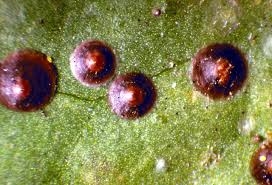Advice from the Help Desk of the UC Master Gardeners of Contra Costa County
Client: I have an Australian Tree Fern that looks unhealthy and appears to be turning reddish-brown. It appeared o.k. until recently. I believe it has adequate shade and water.
photo: Wikipedia
MGCC Help Desk Response: Thank you for contacting UC Master Gardeners of Contra Costa County and bringing the sample of your “scorched” Australian Tree Fern.
We took a look under our microscope at the sample of your Australian Tree Fern (Dicksonia antarctica) your brought in. It appears that you have a red scale (probably California red scale: Aonidiella aurantii) on your fern. This pest would explain the scorched look of your fern stems. Scales are sucking insects that insert their tiny, straw-like mouth parts into bark, fruit, or leaves, mostly on trees and shrubs and other perennial plants. Some scales can seriously damage their host, while other species do no apparent damage to plants even when scales are very abundant. The presence of scales can be easily overlooked, in part because they do not resemble most other insects.
We believe that your scale is an armored scale based on their appearance. The photo displays the pest we see under the microscope.
Image:MGCC
Some scale species, when abundant, weaken a plant and cause it to grow slowly. Infested plants appear water stressed, leaves turn yellow and may drop prematurely, and plant parts that remain heavily infested may die. The dead brownish leaves may remain on scale-killed branches, giving plants a scorched appearance. Scorched appearance is how we would describe the damage to your plant.
Management of Scale - A well-timed and thorough spray of horticultural (narrow-range) oil during the dormant season, or soon after scale crawlers are active in late winter to early summer, can provide good control of most species of scale. Certain scale problems on large plants and hosts especially sensitive to scale damage may warrant the application of a systemic insecticide.
Cultural Control - Provide plants with good growing conditions and proper cultural care, especially appropriate irrigation, so they are more resistant to scale damage. You can prune off heavily infested twigs and branches, if they are limited to a few parts of small plants. In areas with hot summers, pruning to open up canopies can reduce populations of black scale, citricola scale, cottony cushion scale, and possibly other scales by increasing scale mortality from exposure to heat and parasites. You should probably consider replacing problem-prone plants.
The link below from UC Davis (free) will provide more information for you to look over and decide which course of action you wish to take with your fern. There are many choices and the Pest Note outlines each approach: http://www.ipm.ucdavis.edu/PDF/PESTNOTES/pnscales.pdf
Please let us know if you have additional questions.
Help Desk of the UC Master Gardeners of Contra Costa County
Note: The UC Master Gardeners of Contra Costa's Help Desk is available year-round to answer your gardening questions. Except for a few holidays, we're open every week, Monday through Thursday for walk-ins from 9:00 am to Noon at 75 Santa Barbara Road, 2d Floor, Pleasant Hill, CA 94523. We can also be reached via telephone: (925) 646-6586, email: ccmg@ucanr.edu, or on the web at http://ccmg.ucanr.edu/Ask_Us/ MGCC Blogs can be found at http://ccmg.ucanr.edu/HortCoCo/ You can also subscribe to the Blog (see column to the right)